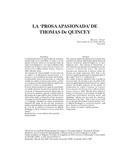| dc.rights.license | http://creativecommons.org/licenses/by-nc-sa/3.0/ve/ | |
| dc.contributor.author | Hoèevar, Drina | |
| dc.date.accessioned | 2009-02-16T22:03:12Z | |
| dc.date.available | 2009-02-16T22:03:12Z | |
| dc.date.issued | 2009-02-16T22:03:12Z | |
| dc.identifier.uri | http://www.saber.ula.ve/handle/123456789/26841 | |
| dc.description.abstract | La dimensión musical significante de la poesía, manifestada en la sonoridad, el ritmo y en las figuras retóricas, debe ser
reconocida como un “nuevo eje lingüístico”, tal como lo afirma Lubio Cardozo en su libro Formas Estructurantes del Poema Lírico (Musicalidad, Tropos, Figuras). 2003. Mérida: Solar. El concepto de “musicalidad” en este autor no se reduce a la dimensión inconsciente, a lo semiótico, en el sentido kristeviano del término. La dimensión onírica inconsciente es conocida cuando los sueños se hacen conscientes. ¿Cómo se comunica esta dimensión musical significante al lector? ¿Cómo es comprendida? El lector de poesía debe ser capaz de aprehender su sentido musical. En nuestro propósito de dar cuenta de la dimensión musical significante de la poesía no podemos ignorar la doble génesis del poema de la que habla Lubio Cardozo en
su obra arriba citada, y al hacerlo se hace necesario investigar la relación significante entre la música y el lenguaje, tomando en cuenta la dimensión temporal del signo. Es por esto que en nuestro trabajo reinterpretamos esas ideas desde el punto de vista de la analítica existencial de Martin Heidegger y de la semiótica existencial de Eero Tarasti. | es_VE |
| dc.language.iso | es | es_VE |
| dc.rights | info:eu-repo/semantics/openAccess | |
| dc.subject | Texto | es_VE |
| dc.subject | Música | es_VE |
| dc.subject | Ritmo | es_VE |
| dc.subject | Pasión | es_VE |
| dc.subject | Temporalidad | es_VE |
| dc.title | La ‘prosa apasionada’ de Thomas de Quincey | es_VE |
| dc.type | info:eu-repo/semantics/article | |
| dc.description.abstract1 | The musical signifying dimension of poetry that manifests in sonority and rhythm and in rhetorical figures should be acknowledged as “a new linguistic axis”. The concept of “musicality” is not reduced to an unconscious dimension, to the semiotic in Kristevan sense. The oneiric unconscious dimension is known when the dreams are made conscious. How then is the musical signifying dimension communicated to the reader? How is it “understood”? The reader of poetry should be able to grasp its musical sense. In our aim to give account of the musical signifying dimension of poetry we cannot ignore the
double genesis of the poem, as mentioned by Lubio Cardozo in Formas Estructurantes del Poema Lírico (Musicalidad, Tropos, Figuras). 2003. Mérida: Solar, and in so doing it is necessary to investigate in depth the signifying relationship between music and language, taking into account the temporal dimension of the sign. That is why in our work we re-interpret those ideas from the point of view of Martin Heidegger’s existential analytic, and Eero Tarasti’s existential semiotics. | es_VE |
| dc.description.colacion | 19-34 | es_VE |
| dc.subject.centroinvestigacion | Centro de Investigaciones Literarias y Lingüísticas Mario Briceño Iragorry | es_VE |
| dc.subject.facultad | Núcleo Rafael Rangel (NURR) | es_VE |
| dc.subject.keywords | Text | es_VE |
| dc.subject.keywords | Music | es_VE |
| dc.subject.keywords | Rhythm | es_VE |
| dc.subject.keywords | Passion | es_VE |
| dc.subject.keywords | Temporality | es_VE |
| dc.subject.publicacionelectronica | Revista Cifra Nueva | es_VE |
| dc.subject.seccion | Revista Cifra Nueva: Artículos | es_VE |
| dc.subject.thematiccategory | Artes y Humanidades | es_VE |
| dc.subject.tipo | Revistas | es_VE |
| dc.type.media | Texto | es_VE |



